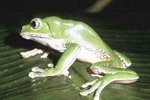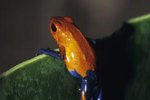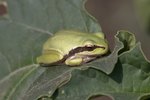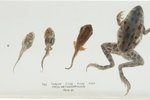
When you see a colorful tree frog looking out of the sheltering hollow in a bromeliad's heart, the animal and plant appear made for each other. Preliminary studies suggest that frogs and bromeliads help each other survive and thrive in their tropical habitats. A tank-type bromeliad makes a natural addition to a pet frog's habitat, or to create a school project ecosystem, classroom or home school display.
Significance
The connection between tropical frogs and bromeliads is so strong that species are named for it, including the bromeliad treefrog and the bromeliad rocket frog. Certain bromeliads have a center tank formed by their rosette of leaves. The tanks or bases of leaves become mini ponds in the wet season. The water helps meet the plants' needs in an environment where nutrients and water can be scarce. High in tropical tree canopies, bromeliads get the bright, filtered sunlight they prefer. The water pools attract insect prey for the frog.
Research
Bromeliads used by frogs receive benefits as well. A treefrog improves a bromeliad's nutrient intake. The frog's feces and insect remains increase the plant's nitrogen, according to Brazilian researchers who published their findings in the 2009 issue of "Oecologia." One type of bromeliad treefrog, Bromeliohyla bromeliacia, shelters in bromeliads during the day and the females lay their eggs in water pools at the base of individual leaves, according to the Operation Wallacea website.
Bromeliad Nursery
The bromeliad serves as a nursery for frog eggs and tadpoles. Not all frogs lay their eggs directly in the bromeliad pools. Female strawberry poison dart frogs in Central and South America lay a clutch of six or seven eggs on a leaf on the ground. The male cares for the eggs until they become tadpoles, and then the female carries the tadpoles on her back one at a time up a tree and puts them in a bromeliad pool, according to the Smithsonian National Zoological Park website. Other poison frogs in rainforests, including Oophaga pumilio, carry their tadpoles from the ground to the tree-top bromeliads.
Considerations
A habitat you create for frogs, such as an enclosure with bromeliads, is called a vivarium or terrarium. A male and female frog of the same species might mate and make more frogs. A narrow-spout watering can works well for filling the bromeliad's tank with filtered water or rainwater. Add water slowly if there are eggs or tadpoles in the bromeliad. Spineless bromeliads (Neoregelia) make a good choice for a frog habitat.
References
- Academia: Nitrogen Fluxes From Treefrogs to Tank Epiphytic Bromeliads --An Isotopic and Physiological Approach
- Operation Wallacea: Climbing for Chytrid -- An Aerial Pursuit for Answers in Honduras
- University of California Museum of Paleontology -- Bromeliflorae The Bromeliads
- Smithsonian National Zoological Park: Smithsonian Zoogoer: Cracking the Egg
- University of Michigan Museum of Zoology: Animal Diversity Web -- Oophaga Pumilio
- Bowling Green State University: Pyllomedusa sauvagi, Waxy Monkey Tree Frogs
Resources
- Clemson University Cooperative Extension: Bromeliads
- Smithsonian Science: Strawberry Dart Frogs Bred at National Zoo for the First Time in Zoo's History
- Rainforest Alliance Kids' Corner: The Poison-Arrow Frog and the Bromeliad
- Arkive: Bromeliad Robber Frog (Pristimantis Bromeliaceus)
- Arkive: Lehmann’s Poison Frog (Oophaga Lehmanni)
- Golden Rocket Frog (Anomaloglossus Beebei)
- Arkive: Marañón Poison Frog (Excidobates mysteriosus)
Photo Credits
-
Jupiterimages/Photos.com/Getty Images
Writer Bio
Gryphon Adams began publishing in 1985. He contributed to the "San Francisco Chronicle" and "Dark Voices." Adams writes about a variety of topics, including teaching, floral design, landscaping and home furnishings. Adams is a certified health educator and a massage practitioner. He received his Master of Fine Arts at San Francisco State University.




